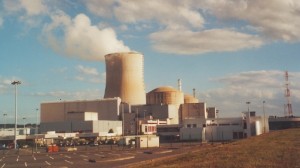 The United States of America is the world’s largest producer of nuclear power, counting for more than 30% of worldwide nuclear generation of electricity. 20% of our energy use in the US is from nuclear power. There are 100 nuclear power plants in 30 different states that produced a total of 798 billion kWh last year in 2014. Today, there are 99 units that are operable and five under construction.
The United States of America is the world’s largest producer of nuclear power, counting for more than 30% of worldwide nuclear generation of electricity. 20% of our energy use in the US is from nuclear power. There are 100 nuclear power plants in 30 different states that produced a total of 798 billion kWh last year in 2014. Today, there are 99 units that are operable and five under construction.
Nuclear energy results from the splitting of uranium atoms called fission. The energy released can be used to make steam that is then used in a turbine to produce electrical energy. Nuclear power has been a debatable epidemic on whether we should use it or not. Some big reasons people are against it is because it is very dangerous, it doesn’t have a safe plan for waste, and it is expensive.
Nuclear waste can remain dangerously radioactive for hundreds of thousands of years. Any leaks can lead to environmental contamination through air particles, groundwater, livestock and crops. Human contamination can lead to radiation sickness, cancer, birth defects, death and many other health hazards. The Chernobyl accident in 1986 is considered the worst nuclear power disaster in Europe. The plant got too hot and exploded from human error, killing the workers that night. The radiation from the explosion blew to other countries and covered most of Europe. Thyroid cancer has increased and many cases of acute radiation syndrome (ARS) was reported and many deaths were the result.
The radioactive materials are not safely secure from leakage or attacks. 2,000 tons of nuclear waste is produced annually from the U.S and they don’t have a central storage facility for it due to the Yucca Mountain Nuclear Repository losing its funding in 2009. It was supposed to hold 70,000 tons of waste, but now U.S Nuclear plants have to currently store their own waste.
The industry uses $7.5 billion per year for the maintenance and upgrading of the nuclear power units. The fuel and personnel costs are high and have been going up steadily. The Vogtle power plant outside Atlanta, Georgia estimated the cost was $1 billion for four reactors and the eventual cost was $9 billion for only 2 reactors. I do think that it could bring fuel prices down for gasoline because we would be using nuclear power instead of those gases, but it still has an outweighing cost than a benefit.
In conclusion, there are some things that are being done to try to lower the risk and damage caused by these power plants. In addition to the worlds commercial nuclear power plants, there are about 240 research reactors currently operating, in 56 countries, with more under construction. These have many uses including research and the production of medical and industrial isotopes, as well as for training.
1. Could nuclear power possibly be the solution to lower high fuel costs?
2. What other precautions are they making to ensure that any accidents like Chernobyl don’t ever happen?
3. Can nuclear power help reduce global warming?
4. Could nuclear power possibly be the main power source for the world instead of the burning of fossil fuels?
This is an animation video that better explains and shows how nuclear energy is produced and used;
Here’s a video that explains and talks more about the Chernobyl Incident: